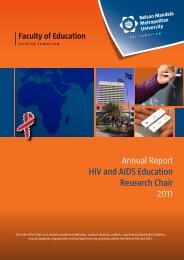USING A DIFFERENT LENS FOR HIV and AIDS EDUCATION ...
USING A DIFFERENT LENS FOR HIV and AIDS EDUCATION ...
USING A DIFFERENT LENS FOR HIV and AIDS EDUCATION ...
You also want an ePaper? Increase the reach of your titles
YUMPU automatically turns print PDFs into web optimized ePapers that Google loves.
The most interesting part of the process of<br />
drawing was the relative ease of the<br />
activity. I could take part in the activity<br />
even though I am absolutely useless at<br />
drawing. My inability to be able to draw<br />
artistically was not a problem. I felt<br />
comfortable displaying <strong>and</strong> talking to the<br />
group about my „poorly‟ drawn picture.<br />
The materials that are required for the<br />
drawing activity are minimal <strong>and</strong> easily<br />
accessible in any situation/context. During<br />
the workshop we were given the<br />
opportunity to make use of coloured<br />
pencils <strong>and</strong> coloured paper but these nice<br />
colourful „extras‟ were not necessary. It<br />
would be acceptable to draw on recycled<br />
paper using pencils or pens as it was the<br />
message that was conveyed <strong>and</strong> the<br />
opportunity for reflection that made the<br />
activity important.<br />
The possibilities for „rich‟ reflection on<br />
these „simple‟, h<strong>and</strong>made drawings were<br />
endless. Each member of the group<br />
willingly showed his/her drawing <strong>and</strong><br />
spoke openly about what the drawing<br />
meant. The other members of the group<br />
also commented on particular similarities<br />
<strong>and</strong> differences in terms of what the<br />
particular drawings represented.<br />
The putting together of the drawings <strong>and</strong><br />
then deciding on a title were also an<br />
important part of the group activity. I<br />
found it interesting that everyone made<br />
Reflecting on using drawing<br />
13<br />
sure that his/her drawing was displayed.<br />
Not one member of the group was<br />
unwilling to put up their drawing – I even<br />
wanted my badly drawn picture displayed<br />
in the centre of the poster!<br />
Each member of the group decided<br />
individually what he/she wanted to draw<br />
before the poster was assembled. The<br />
activity provided opportunities to discuss<br />
ideas about <strong>HIV</strong> <strong>and</strong> <strong>AIDS</strong> education in an<br />
easy yet thought provoking manner. Each<br />
member of the group wanted to share<br />
what his or her drawing represented <strong>and</strong><br />
why he/she considered particular aspects<br />
significant <strong>and</strong> important.<br />
I did not know the names of most of the<br />
members of our group so this activity also<br />
provided an opportunity for us to get to<br />
know each other as well as speak to each<br />
other about our „visions‟ <strong>and</strong> experiences<br />
in <strong>HIV</strong> <strong>and</strong> <strong>AIDS</strong> education. This activity<br />
could easily be adapted as a possible<br />
introduction to integration of <strong>HIV</strong> <strong>and</strong><br />
<strong>AIDS</strong> education in mathematics in preservice<br />
or in-service teaching. From my<br />
research, however, I know that most of<br />
my students have not been adequately<br />
prepared to include <strong>HIV</strong> <strong>and</strong> <strong>AIDS</strong><br />
education or manage <strong>HIV</strong> <strong>and</strong> <strong>AIDS</strong> issues<br />
in a school classroom situation. Perhaps<br />
this activity could be a way of highlighting<br />
the unpreparedness of my pre-service or<br />
in-service teachers?<br />
Linda van Laren



